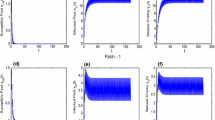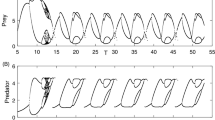Abstract
Natural enemies of insects are extremely important in preventing pest outbreaks in crop fields. Therefore, we investigate the dynamical behavior of a pest-dependent consumption pest–natural enemy (i.e., prey–predator) SEIN model concerning diseases in pest population with three classes (susceptible–exposed–infectious) and impulsive releasing of infectious pests and natural enemies at fixed moments of time. We prove that all solutions of the system are uniformly ultimately bounded. In first part of the main results, the sufficient conditions for local as well as global asymptotic stability of the susceptible and exposed pest extinction periodic solution are determined using a Floquet’s theorem of impulsive differential equations, small-amplitude perturbation skills and comparison theorem. In second part, the sufficient condition for the permanence of a system is determined. These dynamics imply that susceptible and exposed pest populations become extinct when impulse period is less than some critical value and pests coexist with natural enemies at low level when impulse period crosses the critical value. Thus, our results provide some reliable theoretical tactics for pest management and finally these are verified by performing some numerical simulations.




Similar content being viewed by others
References
Arutyunov A, Karamzin DY, Pereira F (2012) Pontryagin’s maximum principle for constrained impulsive control problems. Nonlinear Anal Theory Methods Appl 75(3):1045–1057
Bainov DD, Simeonov PS (1989) System with impulsive effect: stability. Theory and applications, Wiley, New York
Bainov DD, Simeonov PS (1993) Impulsive differential equations: periodic solutions and applications, vol 66. Longman Harlow
DeBach P, Rosen D (1991) Biological control by natural enemies. Cambridge University Press, Cambridge
Dhar J, Jatav KS (2013) Mathematical analysis of a delayed stage-structured predator–prey model with impulsive diffusion between two predators territories. Ecol Complex 16:59–67
Holling C (1965) The functional response of predator to prey density and its role in mimicry and population regulation. Entomol Soc Canada 45:1–60
Huang CY, Li YJ, Huo HF (2012) The dynamics of a stage-structured predator–prey system with impulsive effect and holling mass defence. Appl Math Model 36(1):87–96
Jatav KS, Dhar J (2014) Hybrid approach for pest control with impulsive releasing of natural enemies and chemical pesticides: A plant-pest-natural enemy model. Nonlinear Anal Hybrid Syst 12:79–92
Jiao J, Chen L, Cai S (2009) Impulsive control strategy of a pest management SI model with nonlinear incidence rate. Appl Math Model 33(1):555–563
Karamzin DY (2006) Necessary conditions of the minimum in an impulse optimal control problem. J Math Sci 139(6):7087–7150
Lakshmikantham V, Bainov DD, Simeonov PS (1989) Theory of impulsive differential equations. World Scientific, Singapore
Liu X (2014) Impulsive periodic oscillation for a predator–prey model with Hassell–Varley–Holling functional response. Appl Math Model 38(4):1482–1494
Rishel RW (1965) An extended Pontryagin principle for control systems whose control laws contain measures. J Soc Ind Appl Math Ser A Control 3(2):191–205
Shi R, Chen L (2010) An impulsive predator-prey model with disease in the prey for integrated pest management. Commun Nonlinear Sci Numer Simul 15(2):421–429
Shulgin B, Stone L, Agur Z (1998) Pulse vaccination strategy in the sir epidemic model. Bull Math Biol 60:1–26
Song X, Hao M, Meng X (2009) A stage-structured predator–prey model with disturbing pulse and time delays. Appl Math Model 33(1):211–223
Song XWW (2010) Analysis of an impulsive pest management SEI model with nonlinear incidence rate. Comput Appl Math 29(1):1–17
Stoner K (1998) Approaches to the biological control of insects. University of Maine Cooperative Extension
Vandermeer J, Stone L, Blasius B (2001) Categories of chaos and fractal basin boundaries in forced predator-prey models. Chaos Solitons Fractals 12:265–276
Wu X, Du W, Pan G, Huang W (2013) The dynamical behaviors of a Ivlev-type two-prey two-predator system with impulsive effect. Indian J Pure Appl Math 44(1):1–27
Xiang Z, Li Y, Song X (2009) Dynamic analysis of a pest management SEI model with saturation incidence concerning impulsive control strategy. Nonlinear Anal Real World Appl 10(4):2335–2345
Yu H, Zhong S, Agarwal RP (2011) Mathematics analysis and chaos in an ecological model with an impulsive control strategy. Commun Nonlinear Sci Numer Simul 16(2):776–786
Zhao M, Wang X, Yu H, Zhu J (2012) Dynamics of an ecological model with impulsive control strategy and distributed time delay. Math Comput Simul 82(8):1432–1444
Acknowledgments
K. S. Mathur would like to thank to the University Grant Commission, New Delhi for financial supports under UGC-BSR Start-Up Grant Project, No. F-56/2014 (BSR).
Author information
Authors and Affiliations
Corresponding author
Additional information
Communicated by Maria do Rosário de Pinho.
Appendices
Appendix 1
Proof of Theorem 2
Let (S(t), E(t), I(t), N(t)) be any solution of (2.1). Using Theorem 1 the susceptible and exposed pest eradication periodic solution (0, 0, I(t), N(t)) is locally asymptotically stable; therefore, we only need to prove its global attraction. Since \(T<\frac{1}{r}(\frac{\beta _1p_1}{\mu _1(1+mK)}+\frac{\beta _2p_2}{\mu _2})\), we can choose \(\epsilon _1>0\) small enough such that
From the third equation of the system (2.1), we have
Consider the comparison system
\(\square \)
Using the Lemma 3, we obtain that the system (7.1) has a periodic solution
which is globally asymptotically stable. In view of Lemma 3 and comparison theorem of impulsive equation (Bainov and Simeonov 1993), we have \(I(t)\ge v(t)\) and \(v(t)\rightarrow \widetilde{v}(t)\) as \(t\rightarrow \infty .\) Then there exists an integer \(k_1\) such that
Similarly, there exists an integer \(k_2 \ (k_2>k_1)\) such that
Thus, for \(t\ge k_2 T\), from first equation of the system (2.1), we have
Integrating (7.4) on \((k_2T,t]\), which yields
where \(t\in ((k_2+k)T, (k_2+k+1)T],\ k\in Z_+\). Since \(\sigma _1 <0\), we can easily obtain that \(S(t)\rightarrow 0\) as \(k\rightarrow +\infty \). Thus, for an arbitrary positive constant \(\epsilon _2\) small enough, there exists an integer \(k_3\ (k_3>k_2)\) such that \(S(t)<\epsilon _2\) for all \(t\ge k_3T\). Hence, we can obtain an integer \(k_4\ (k_4>k_3)\) such that \(\frac{\beta _1S(t)I(t)}{1+mS(t)}<\epsilon _1\) for all \(t\ge k_4T\). From the second equation of the system (2.1), we have
which yields that \(\displaystyle E(t)\le E(0^+)e^{-(\alpha +\mu _1)t}+\frac{\epsilon _1}{\alpha +\mu _1}- \frac{\epsilon _1}{\alpha +\mu _1}e^{-(\alpha +\mu _1)t}\) \(\rightarrow 0\) as \(t\rightarrow \infty \). Thus, there exists an integer \(k_5\ (k_5>k_4) \) such that \(E(t)<\epsilon _2\) for all \(t\ge k_5T\).
Again from the third equation of the system (2.1), we have
Consider the following impulsive system
Using the Lemma 3, we obtain that the system (7.5) has a periodic solution
which is globally asymptotically stable. Again, in view of Lemma 3 and comparison theorem of impulsive equation Bainov and Simeonov (1993), we have \(I(t)\le w(t)\) and \(w(t)\rightarrow \widetilde{w}(t)\) as \(t\rightarrow \infty .\) Then there exists an integer \(k_6\ (k_6>k_5)\) such that
From the fourth equation of the system (2.1), we obtain that
Using similar argument, there exists an integer \(k_7 \ (k_7>k_6)\) such that
where \(\displaystyle N^*(t)=\frac{p_2\exp \left( -\left( \mu _2-\gamma \beta _2\epsilon _2 \right) (t-nT)\right) }{1-\exp \left( -\left( \mu _2-\gamma \beta _2\epsilon _2 \right) T\right) },\ \ nT<t\le (n+1)T, n\in Z_+.\) Note that \(\epsilon _1\) and \(\epsilon _2\) are positive constant small enough; therefore, \(\widetilde{w}(t)\rightarrow \widetilde{I}(t)\), \(N^*(t)\rightarrow \widetilde{N}(t)\), as \(\epsilon _2\rightarrow 0\). Thus, it is obtained that \(I(t)\rightarrow \widetilde{I}(t)\) and \(N(t)\rightarrow \widetilde{N}(t)\), as \(t\rightarrow +\infty \). Therefore, the exposed and infectious pest eradication periodic solution \((0,0,\widetilde{I}(t),\widetilde{N}(t))\) of (2.1) is globally asymptotically stable.
Appendix 2
Proof of Theorem 3
Suppose (S(t), E(t), I(t), N(t)) is a solution of the system (2.1). From the boundedness of the solution, we get that \(S(t)\le M,\ E(t)\le M,\ I(t)\le M\) and \(N(t)\le M\) for all \(t\ge 0\). \(\square \)
From the Eqs. (7.2) and (7.3), it is obtained that
Therefore, I(t) and N(t) are ultimately positively bounded below.
Since \(T>T_\mathrm{max}\), therefore, we can select positive constants \(\epsilon _3\) and \(m_3\) \((0<m_3<K)\) small enough such that
Now, for the permanence of the system, we only need to find \(m_3\) and \(m_4\) such that \(S(t)\ge m_3\) and \(E(t)\ge m_4\) for large enough t. First, we prove \(S(t)\ge m_3\) for large enough t, and the result is proved in two steps.
Step I First, assume that \(S(t)\ge m_3\) is not true, then there exists a \(K_1\in Z_+\), such that \(S(t)< m_3\) for all \(t\ge K_1T\). Using this assumption, we get following subsystem of the system (2.1):
Consider the following comparison system:
Using the Lemma 3, the system (8.1) has a periodic solution
which is globally asymptotically stable. Then, there exists an \(N_2\ (K_2>K_1)\) such that
Again from the system (2.1), we can obtain following impulsive system:
Consider the following comparison system:
Using similar argument, we obtain that
Thus, from the system (2.1) we can obtain that
which yields that
Thus, it is easily got that \(S((K_2+k)T)\rightarrow +\infty \) as \(k\rightarrow +\infty ,\) which is a contradiction with the boundedness of S(t). Hence, for an arbitrary \(K_1\in Z_+\), there exists a \(t_1>K_1T\) such that \(S(t_1)\ge m_3\).
Step II If \(S(t)\ge m_3\) for all \(t\ge t_1\), then our aim will be fulfilled. Otherwise, \(S(t)<m_3\) for some \(t> t_1\). Let \(t^*=\inf \ \{t\ |\ S(t)<m_3,\ t>t_1\}\), then we have, \(S(t)\ge m_3\) for \(t\in [t_1,t^*)\) and \(t^*\in (n_1T,(n_1+1)T]\), \(n_1\) is some positive integer. It is easily obtain that \(S(t^*)=m_3\), since S(t) is continuous. Assume that \(T_1=n_2T+n_3T,\) where \(n_2\) and \(n_3\) satisfy the following inequalities:
Now, we claim that there exists a time \(t'\in ((n_1+1)T,(n_1+1)T+T_1)\) such that \(S(t')\ge m_3,\) if it is not true, then true, then \(S(t)<m_3,\ t\in ((n_1+1)T,(n_1+1)T+T_1)\). If the system (8.1) is considered with initial value \({w_1}({(n_1+1)T}^+)=I({(n_1+1)T}^+)\), then using Lemma 3 for \(t\in (nT,(n+1)T]\) and \(n_1\le n \le n_1+n_2+n_3\), we have
which evidence that
and \(I(t)\le {w_1}(t)<\widetilde{{w_1}}(t)+\epsilon _4\) for all \((n_1+n_2+1)T\le t\le (n_1+1)T+T_1\).
Now, we consider the system (8.2) with initial value \({w_2}((n_1+1)T+n_2T)^+=N((n_1+1)T+n_2T)^+\ge 0\). Again using the Lemma 3, we obtain that
and \(N(t)\le {w_2}(t)<\widetilde{{w_2}}(t)+\epsilon _4\) for \((n_1+n_2+1)T\le t\le (n_1+1)T+T_1.\) Thus, we have
for all \(t\in [(n_1+1)T+n_2T,(n_1+1)T+T_1]\). Integrating on \([(n_1+1)T+n_2T,(n_1+1)T+T_1]\), we get
Now for \(t\in (t^*,(n_1+1)T]\), there are two possible cases:
Case (a) If \(S(t)<m_3\) for \(t\in (t^*, (n_1+1)T]\), then \(S(t)<m_3\) for all \(t\in (t^*, (n_1+1+n_2)T]\). Therefore, we have
On integrating the system (8.4) in the interval \([t^*,(n_1+1+n_2)T]\), it is obtain that
substituting (8.5) into (8.3), we get that
which is a contradiction. Let \(\check{t}=\inf \{t|\ S(t)\ge m_3,\ t>t^* \}\), then \(S(\check{t})=m_3\). For \(t\in [t^*,\check{t})\), (8.4) holds. Integrating (8.4) on \([t^*,\check{t}\), we have
Since \(S(\check{t})\ge m_3\) for \(t>\check{t}\), the same argument can be continued. Hence, we have \(S(t)\ge \overline{m_3}\) for all \(t>t_1\).
Case (b) There exists \(t''\in (t^*,(n_1+1)T\) such that \(S(t'')\ge m_3.\) Let \(\bar{t}=\inf \{t|\ S(t)\ge m_3,\ t>t^* \}\), then \(S(t)<m_3\) for \(t\in [t^*,\bar{t})\) and \(S(\bar{t})=m_3\). For \(t\in [t^*,\bar{t})\), (8.4) holds. Integrating (8.4) on \([t^*,\bar{t})\), we have
The same argument can be continued, since \(S(\bar{t})\ge m_3\). Hence, we have \(S(t)\ge \overline{m_3}\) for all \(t>t_1\). Thus, in both cases, we conclude \(S(t)\ge \overline{m_3}\) for all \(t\ge t_1\). This proves that S(t) is ultimately positively bounded below.
Secondly, we prove that E(t) is ultimately positively bounded below. Since the function \(\frac{\beta _1S(t)}{1+mS(t)}\) is monotonically increasing for \(S(t)\ge 0\), from the second equation of system (2.1), we have
we can easily obtain that \(\lim _{t\rightarrow +\infty }\ \inf E(t)\ge m_4\), where \(\displaystyle m_4=\frac{\beta _1 \overline{m_3}m_1}{(1+m\overline{m_3})(\alpha +\mu _1)}\).
Now using Step I and Step II, let us define \(m=\min \{m_1,m_2,\overline{m_3},m_4 \}\) and \(\Omega =\{(S,E,I,N)\ :\ m\le S(t),E(t), I(t), N(t) \le M \}\). We know that \(\Omega \subset int R_+^4\) is a global attractor and hence every solution of system (2.1) with positive initial values will eventually enter and remain in region \(\Omega \). This evidences that the system (2.1) is permanent.
Rights and permissions
About this article
Cite this article
Mathur, K.S., Dhar, J. Stability and permanence of an eco-epidemiological SEIN model with impulsive biological control. Comp. Appl. Math. 37, 675–692 (2018). https://doi.org/10.1007/s40314-016-0365-1
Received:
Revised:
Accepted:
Published:
Issue Date:
DOI: https://doi.org/10.1007/s40314-016-0365-1




